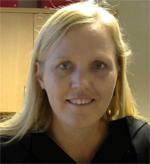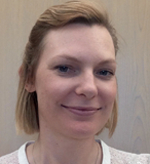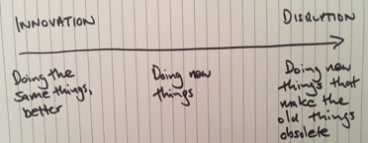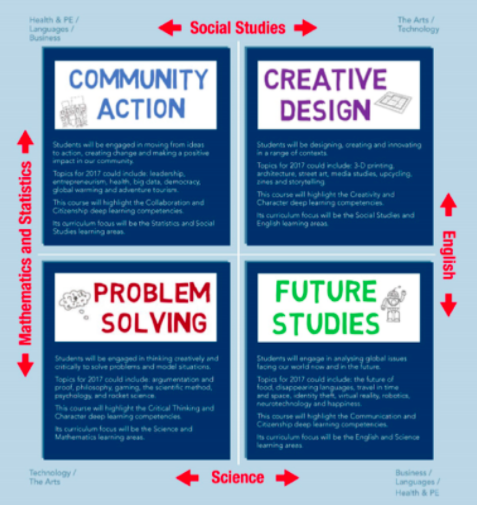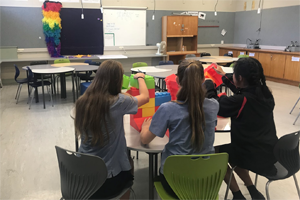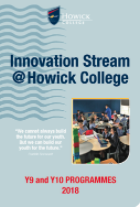Teachers from Howick College have designed an integrated curriculum for their learners called The Innovation Stream.
Howick College Associate Principal Louise Addison (left) and Angela McCamish (right), Director of the Innovation Stream, share their integrated approach to learning in a mainstream secondary setting.
What is the Innovation Stream?
The Innovation Stream is an integrated curriculum designed to develop learners, leaders, and change-makers who use knowledge meaningfully across the core subjects of English, maths, science, and social studies. It focuses on the development of six innovation capabilities:
- Character – including building resilience, leadership, and initiative
- Citizenship – understanding different viewpoints and ways of thinking
- Communication – developing strong oral, written, visual, and digital literacy
- Collaboration – working in teams to learn with and from others
- Creativity – to develop qualities like entrepreneurship, flexibility, and curiosity
- Critical thinking – in which students apply critical and analytical thought processes to address a range of real-world applications of problem solving.
Key competencies
The team at Howick College use their six innovation capabilities to bring the key competencies to life. The capabilities are broken down into specific skills with "I" statements so that learners know what each capability looks like in action.
Weaving learning areas with key competencies
Competencies, knowledge, and skills that students will need for addressing real-life situations are rarely confined to one part of the curriculum. The Innovation Stream at Howick College integrates content knowledge from a range of learning areas with the school's six innovation capabilities.
This new programme introduces four cross-curricular "subjects" – future studies, community action, creative design, and problem solving – which students study instead of the traditional core subjects of English, mathematics, science, and social studies.
A successful application for the Teacher Led Innovation Fund (TLIF) in 2017 has enabled teachers to examine the effectiveness of the overall course in accelerating learning alongside development of 21st century capabilities: citizenship, character, communication, collaboration, creative and critical thinking (Fullan, Langworthy & Barber, 2014). Part of this inquiry is investigating how the NZC principles of coherence and future focus might be used to construct, design, and review a secondary school curriculum.
What led to the development of the Innovation Stream?
In observing presentations of senior students, Louise felt that further opportunities to develop the key skills of communication and collaboration could be provided at Howick College. She wanted to really get the students excited and engaged in real life situations so she looked at how this could be done in a traditional school environment.
She was also thinking about the need to prepare students for the "exponential age" and 21st century learning. Today’s students are entering a different world to that of their parents and teachers, with new job and learning opportunities. These opportunities need students who can think deeply about issues, solve problems creatively, communicate clearly in a variety of media, learn ever-changing technologies, and deal with multiple sources of information. The rapid changes in the world require students to be flexible, to take the initiative and lead when appropriate, to collaborate with others with a range of expertise, and to create new and useful products and processes.
“Doing things the way we’ve always done them won’t change anything.”
Louise
It made sense to start with a small group of year 9 students so it didn’t require massive changes for both staff and students. They began with voluntary applications and wrote a brochure to explain the Innovation Stream to students and whānau. Louise presented this information at a parents’ evening and at feeder schools to students and parents who seemed very open to the Innovation Stream as a programme of learning and the importance of developing students’ soft skills. Angela was then appointed as Director of the Innovation Stream to oversee development and implementation of the programme.
Many applications came in, far more than they could take. Louise and Angela were looking for a certain student in the first instance – those who were motivated and "pioneers", not necessarily the high achievers academically. They found it fascinating discovering the range of students’ passions as part of this application process.
They presented their idea to the rest of the staff and asked those who may be interested to attend a meeting. They had 30% attendance, which was more than expected. It seemed a risk for teachers at first as it requires a shift in mindset from traditional single cell teaching. Team teaching is not very common at secondary.
In 2017 eight staff were involved and in 2018 more have got on board so now there are 17 teachers, 54 year 9 students, and 30 students in year 10. The year 10 cohort includes 28 students from the year 9 class of 2017. Two students from the original cohort have moved to another region which has allowed a place for two new students.
Getting started
Angela and Louise worked with teachers who had shown an interest in the programme and with timetablers to finalise the first teaching team of eight staff. In 2017 this team taught the Innovation Stream class in a prefab, two teachers working together. The programme did require significant commitment from these teachers as they met to plan together on a weekly basis, as well as being part of the wider Innovation team.
Angela, whose subject is English, teaches with a young science teacher in the area of future studies. She says it gives them regular opportunities to sit down and talk about the students, something that doesn’t generally happen between teachers in different subject areas at secondary level.
“Teachers are learning to be more flexible. It took a term at the beginning of last year to get the balance right. It’s hard not to focus on coverage, rather than on rich tasks. Co-teaching is so new to everyone. We could have left the class for one to teach on their own but actually both teachers ended up staying in the classroom the whole time. A lot of the planning happened in the room. We’ve really grown an appreciation for what our colleagues can do across the learning areas – what’s specific to subjects. And it helps to have someone from the senior management involved.”
Angela
How is it structured?
The diagram below shows the four core subject areas from the New Zealand Curriculum and how they are incorporated into the four Innovation Stream courses. As this is an integrated approach, aspects of the health and PE, languages, business, the arts, and technology curricula are also used to support meaningful learning.
Innovation Stream @ Howick College – Year 9 and Year 10 programmes 2018, p. 3
The names of the courses has helped to shift mindsets for students, whānau, and teachers as more focus is put on authentic contexts for "problem solving" or "designing" and less on "covering year 9 content".
Coherence principle
The Innovation Stream at Howick College is consistent with the coherence principle, which states that the curriculum offers all students a broad education that makes links within and across learning areas, and opens up pathways to further learning.
What changes has the Innovation Stream brought to a school day for students?
Innovation Stream year 9 and 10 students are together for 15 out of 25 hours per week. During that time, they remain in their own room while their teachers come to them. While that was a prefab last year, this year they have their new designated space (see below).
The nature of what they’re doing is different from normal subject classes. For example:
- there are fewer written tasks
- there is a greater need to collaborate
- there is a big focus on the six capabilities
- togetherness is a strong feature
- having two or three teachers in the classroom at the same time
- getting more exposure to different technologies, for example, 3D printer, virtual reality (coming up), robotics, drone software.
Year 9 has 54 students in one big room with three teachers who do all their planning together. The room is timetabled as either two large interconnected classrooms or a classroom and a lab for science mix courses. That means higher staffing which we are currently able to do with TLIF funding as it pays for teacher release and professional development.
What have the benefits been so far for the teachers?
- PLD support
- Teachers and learners getting their "spark" back.
- Being open to learning; the learning comes first.
- “Less mucking around” – when there are two teachers to share the learning action they tend to get through work more quickly than initially anticipated.
- The pairing of teachers from different subjects provides important learning opportunities. For example, the second teacher in the space unit had never seen 3D printing in action before, but feels confident she could now use this technology too.
- One teacher said he could “never go back to a traditional class now”. He clarified that what he meant was that the ways of working in the Innovation Stream were spilling over into his mainstream classes.
- Another teacher who was new to the HOD role said the experiences of working in the Innovation Stream had given her the confidence to think differently about “coverage” in mainstream classes.
What have been the main challenges for teachers to change their practice?
- Secondary subject teachers are traditionally not set up to be interdisciplinary so it’s a lot harder for teachers to make time to meet outside of the classroom.
- Some teaching pairs didn’t match so well (most did). It’s more about personality rather than expertise.
- Significantly more guiding from the side/facilitating learning than leading from the front.
- Giving feedback on the capabilities and not just curriculum content.
- Teachers were sometimes pushed beyond the boundaries of their current experiences and found themselves needing to learn with the students as they went, especially when working with exponential technologies and futuristic trends.
- Thinking differently about assessment. Finding a way to assess capabilities.
What have been the main challenges for the students?
The hardest thing was the leap of faith at the start of the programme. The students really needed to have a "pioneer" mentality. Initially some students struggled with:
- having to think for themselves
- wanting to move from class to class when they first arrived at secondary school
- wanting to go back to what they felt more comfortable with
- taking risks
- significant amounts of group work and collaboration
- presenting findings to the class for critique and feedback from their peers
- more critiquing to help them develop as a learner.
The first few weeks were challenging for the students but once they settled into the class, and the less familiar ways of working, the students really stepped up to meet these challenges.
What have been the benefits for students?
Teachers reported at the end of 2017 that the level of persistence students have demonstrated was “beyond what we expect of year 9”. Students were not expected to sit the traditional end of year examination for other year 9 classes but they wanted to do so. They were given a mix of half the items other students attempted and some more challenging questions written just for them. This willingness to step up and be challenged reflected the “different attitude” to learning that they had developed during the year.
The Innovation Stream performed significantly above the mainstream across the core areas. They also performed at or above the upper band in all four core subjects.
“Learning with the same small group that are all inspired and with a will to learn. It’s really good to be in an environment that is so welcoming and safe. I'm never embarrassed to ask questions as I now know that most people are thinking the same thing and the answer will benefit. I think that if I had of been in a mainstream class I would not of been so motivated to learn and I would never have stepped out of my comfort zone and tried new exciting things.”
Year 9 student
“The innovation stream was an opportunity to learn in a way I had never before and that is what I love most about it. For once we engage and love our learning because we don’t just learn English, math, science, we learn about life and how to apply our learning to our life.”
Year 9 student
“I have enjoyed when we have put together ideas for inventing things and making change in the community, especially the school. For example, after we went to Tiaki Expo, we got into groups and thought about the things we could do to improve the school.”
Year 9 student
What feedback have you had from parents/whānau?
The type of parents who supported their children to be involved in the Innovation Stream were those willing to give it a go. Feedback from the students was shared with whānau.
“That's great feedback from the students. It's easy to see how much they're enjoying Innovation Stream. I thought it was very interesting that the favourite thing for the majority of them is the collaboration and the friendships they're making. They like having the same people in multiple classes – it makes it more enjoyable to attend class. As a parent I'm very happy with the life skills the kids are learning too, and the way everything has been conducted.”
A parent
“I wish all kids could learn like this, I know my child has got so much from the programme and is looking forward to continuing with it next year.”
A parent
Were there any surprises?
- The learning demonstrated exceeded the teachers’ expectations of year 9 students in more traditional classes.
- The students’ response to the programme, that is, dealing with uncertainty.
- The level of agency students exercised in their learning. This is reflected in the willingness of the students to continue their learning beyond class time, and the level of commitment and stretch they are prepared to demonstrate. They are highly motivated.
How are you expanding this in 2018 and 2019?
In 2018 the year 9s are not doing the same topics necessarily as in 2017. For example, they are doing Zero Waste rather than Upcycling. They could be developing new units every year.
They would like more parent involvement. At this stage, they are only reporting to parents.
“We want to set up genuine problem solving tasks. We are collecting these but we’d like to extend that to parents. We want to identify really good problems, for example, design aspects of a job, and parent expertise would be valuable here.”
Louise
Year 10s have a timetable day to work on a passion project. This will also allow teachers to get some ideas from these when planning future units. Some students will go off site for their "edge" projects, living or learning on the "edge" of one’s competence.
“We’re making it up as we go along. That’s exciting but a bit scary. We are always thinking and working in advance, for example, what they will be working on in year 11?”
Louise
In 2019 they plan to involve 150 year 9 to 11 students.
What advice would you offer to other secondary schools?
- Do it! It’s terrifying but rewarding. If you don’t do it, things won’t change.
- Put your faith in your teaching team and the structure and you can’t go wrong.
- Stick with it, especially in the first term.
- Don’t always anticipate what change will happen so deal with it as it comes. It is problem solving on the spot.
You might like ...
Teacher-led Innovation Fund (TLIF): Summaries of completed projects (May 2018)
This report brings together the summaries of the Teacher-led Innovation Fund (TLIF) projects which have already been successfully completed. They demonstrate teaching practices in innovative and exciting ways or explore new practices to improve learning outcomes.
- Tags:
- coherence
- curriculum design and review
- integrated curriculum
- key competencies
- learning areas
- secondary
Return to top

